D&D.Sci(-Fi) June 2021 Evaluation and Ruleset
post by abstractapplic · 2021-06-29T21:02:20.072Z · LW · GW · 5 commentsContents
Ruleset Heteropneums Who Fights What Fighting (as Maria) Alpha Beta Gamma Delta Epsilon Zeta Eta Fighting (as anyone else) Strategy Reflections Scheduling None 5 comments
This is a followup to the D&D.Sci post [LW · GW] I made last week; if you haven’t already read it, you should do so now before spoiling yourself.
Here is the web interactive I built to let you evaluate your solution; below is an explanation of the rules used to generate the dataset. You’ll probably want to test your answer before reading any further.
Ruleset
This challenge runs mostly on Poisson distributions; the rest of this post will abbreviate “Take the result of a Poisson process with lambda=X” as “Po(X)”.
Heteropneums
There are two types of heteropneum. The most common is the garden-variety heteropneum, which exists as a natural consequence of the way soul energy clusters. This type has a randomly-generated amplitude which is always a multiple of 0.142 kCept. (You can infer that Earwax must not be of this kind because no amplitude which would round to 3.2 kCept is a multiple of 0.142 kCept.)
There are also a much smaller number of [Teeming] heteropneums, which exist because the [Teeming] hivemind does. These appear at times and with intensities not determined by the rules of this world (in other words, decided arbitrarily by the GM). Nicholas, Neville, Jasper, Athena, Endeavour, Spindle, Divisor, Desk, Pencil, Duchess, Economy, Sirocco, Constellation, Harbinger, Minimalist, Spackle, Tourniquet, Painting, Toast, and most importantly Earwax are [Teeming] heteropneums; all others are not.
Who Fights What
Heteropneums with amplitudes of >2.5 kCept are handled by Maria. Heteropneums in the 1.2-2.5 kCept range are split evenly between Maria and Janelle. Weaker heteropneums are allocated unevenly between all viable pilots.
Fighting (as Maria)
Let A be the amplitude of the heteropneum Maria is facing, in kCept.
Alpha
Alpha Resonance lets Maria create 3.4444 + 0.0285*Po(10.2) kCept of Effective Field Strength. On Floorday 502, a breakthrough was made which allowed the Sphere’s submarines to better utilize this form of Resonance; this adds an extra 0.5111 kCept.
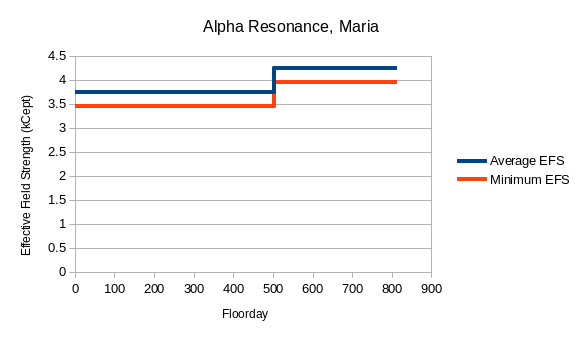
Beta
Beta Resonance lets Maria create 2.4011 + 0.1034*Po(3.9) kCept of Effective Field Strength.
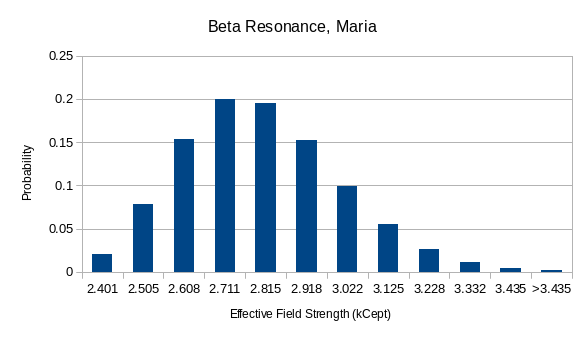
Gamma
Gamma Resonance gets stronger as the enemy does. It lets Maria create 0.6626 + A*0.66*Po(1.1) kCept of Effective Field Strength.
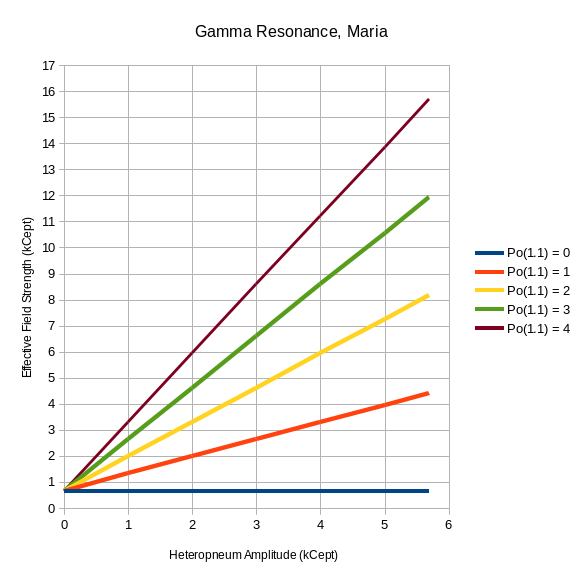
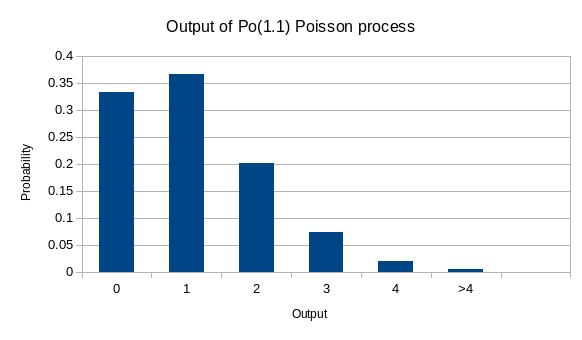
Delta
Delta Resonance is Maria’s preferred means of attacking. It lets her create A*0.32 + 3.253 + 0.0882*Po(19.2) kCept of Effective Field Strength.
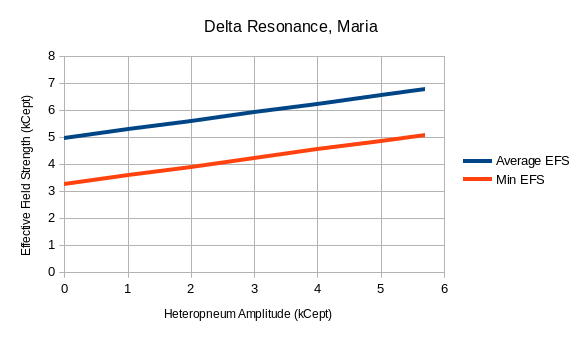
Epsilon
Epsilon Resonance has a complex but predictable effect. It lets Maria create 0.46 - 1.12*A + 0.93*A^2 - 0.14*A^3 kCept of Effective Field Strength.
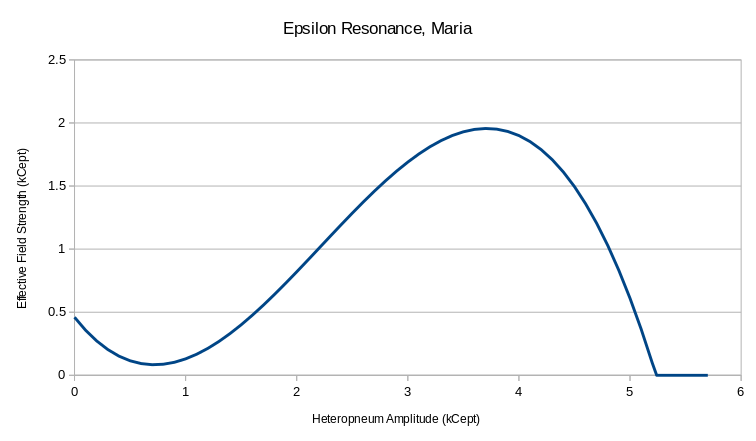
Zeta
Zeta Resonance randomly fails and produces 0kCept 22% of the time. When it succeeds, it lets Maria create 2.1571 kCept of EFS against an ordinary heteropneum, or 7.5311 kCept against a [Teeming] heteropneum.
Eta
Eta Resonance varies sharply and arbitrarily with time, as shown below.
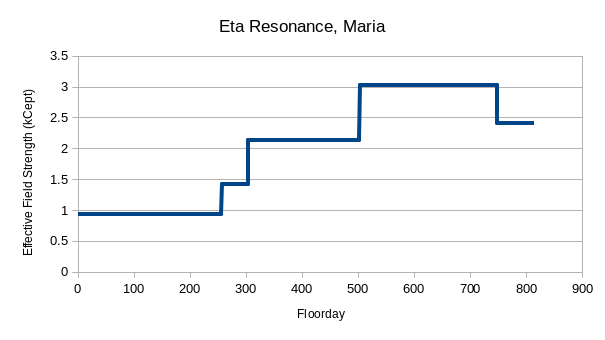
Fighting (as anyone else)
Every pilot/Resonance combination has a factor representing how well that pilot handles that resonance compared to Maria. The EFS they generate is always the EFS Maria would generate multiplied by that factor. All factors are tabulated below.
| Janelle | Amir | Corazon | Flint | Will | |
| Alpha | 0.48 | 0.50 | 0.59 | 0.42 | 0.23 |
| Beta | 0.98 | 0.72 | 0.11 | 0.32 | 0.55 |
| Gamma | 1.34 | 0.42 | 0.58 | 0.36 | 0.14 |
| Delta | 0.24 | 0.34 | 0.16 | 0.32 | 0.21 |
| Epsilon | 0.79 | 0.78 | 0.35 | 1.23 | 2.11 |
| Zeta | 0.43 | 0.41 | 0.92 | 0.39 | 0.12 |
| Eta | 0.45 | 0.23 | 0.12 | 1.08 | 0.95 |
Strategy
Once you know everything about this system, the two dominant solutions are to have Will use Epsilon Resonance (100% chance to live), or have Corazon use Zeta Resonance (22% chance to die, 78% chance to live and replace Soul Coherence Theory). However, the small amount of data you were provided may not have been enough for you to confidently assess how reliably Zeta Resonance works on [Teeming] heteropneums, and/or you may have suspected that Earwax is unique enough that Zeta Resonance wouldn’t treat it like other [Teeming]s; thus, you may have reasonably opted for having Janelle use Gamma Resonance (~33% chance to die, ~37% chance to live but keep SCT, ~30% chance to live and replace SCT). Ultimately, your choice depends on your values and your circumrational reasoning.
(You may also choose to sabotage the fight and kill everyone. But why would a Sphere scientist ever do something like that?)
Reflections
This scenario was a puzzle; for once, I think that’s justified. When dealing with a problem rooted in (Meta)Physics and (Xeno)Biology instead of Economics and Sociology, exact predictions become sensible goals and sophisticated modelling becomes a valid tactic. The fact that it had three intended solutions made me comfortable turning up the difficulty for this one: congratulations to everyone who found at least one answer, and particular congratulations to simon for finding the two optimal ones.
This scenario was also fanfiction. It . . . probably shouldn’t have been. I had hoped that using someone else’s canon would let me borrow gravitas, cut down on exposition, and enable players’ pre-existing attitudes towards the characters both motivate and bias them. This was undercut somewhat by the fact that – to my surprise – literally 0% of players seem to have read Floornight (in my defence, it was big on rationalist tumblr!). But the main problems were inherent to the idea: it’s hard to write an introduction such that it works for both fans and non-fans, ~700 words of problem description just isn’t enough for me to successfully cloud people’s judgement, and the whole “solve this puzzle or your husbando gets it!” conceit seems tacky in hindsight (especially given I didn’t invent the husbando in question). Next time I do a D&D.Sci challenge as fanfic, I’ll pick a less obscure story; and next time I try to inflict Feels on you, I’ll use both a better format and original characters.
Finally, this scenario was Sci-Fi, with capital letters and everything. No dungeons, no dragons, no questing heroes, and most importantly no dicerolls. I’m conflicted both about whether Sci-Fi is less likely than Fantasy to alienate potential players, and about whether using ‘grown-up’ distributions that could conceivably show up in players’ dayjobs is an improvement over my usual approach.
. . . this is typically the part where I say “Feedback on these points, and on all other points, is enthusiastically solicited”, but it’s possible Nostalgebraist might read this and I want him to think I’m cool. Therefore: I cooly solicit cool feedback on these cool points (in a cool sort of way).
Scheduling
I've just started a new job. This shouldn’t interfere with making July’s challenge – especially since I’ve done all the conceptual work for it already – but unexpected delays are a lot more likely. Best guess: I’ll post it towards the end of next month.
5 comments
Comments sorted by top scores.
comment by Xeno of Citium · 2021-07-01T18:40:16.779Z · LW(p) · GW(p)
I read Floornight because of this post and it was very good. So, there was at least some benefit to making this fanfiction.
comment by SarahNibs (GuySrinivasan) · 2021-06-30T14:43:31.979Z · LW(p) · GW(p)
This was a fun one! Post-mortem:
Biggest miss is that I failed to guess that the distributions were identical up to a constant person/resonance multiplier. Actually I did guess that initially, but decided it probably wasn't true, which is why it's my biggest miss. I started thinking it when Maria hit more x1s than x0s on Gamma while Janelle hit more x0s than x1s, leading me to think that there were more person-dependent factors than just one. IIRC the nail in the coffin of that theory was looking at Epsilon resonance. It was clear that Epsilon was non-random and inspecting the overlapping areas of the curve showed (e.g.)
A|Janelle|Maria|multiplier
-----
0.28|0.17|0.21|0.86
1.28|0.20|0.26|0.77
Later, I lowered my confidence in Will's Epsilon prediction because I knew our instruments have limited precision. I didn't connect that with "maybe 0.77 vs 0.86 isn't that far off given imprecision!".
Also I think I was modeling the precision incorrectly, probably. I took "for example, since they say Earwax has an amplitude of 3.2 kCept, you can be 100% sure the true value is between 3.15 and 3.25 kCept" to mean that every value could be plus or minus 0.05, but I think now it actually meant that values were rounded to the nearest digit shown, so a listed value of 0.28 kCept was not between 0.23 and 0.33, but rather between 0.275 and 0.285?
Biggest hit, I think, was correctly determining Janelle's actual chances: I said 25% win, 39% double; actual was 37% win, 30% double. Method was seeing graphs that were clearly 5 linear trends by power, estimating the zero, estimating their slopes, and noticing the multiplier.
Replies from: abstractapplic↑ comment by abstractapplic · 2021-07-03T19:55:05.246Z · LW(p) · GW(p)
Also I think I was modeling the precision incorrectly, probably. I took "for example, since they say Earwax has an amplitude of 3.2 kCept, you can be 100% sure the true value is between 3.15 and 3.25 kCept" to mean that every value could be plus or minus 0.05, but I think now it actually meant that values were rounded to the nearest digit shown, so a listed value of 0.28 kCept was not between 0.23 and 0.33, but rather between 0.275 and 0.285?
Yes, that's exactly what happened. That ambiguity didn't occur to me; I've now edited the original post to clarify so future players won't have the same issue; mea culpa.
comment by simon · 2021-06-30T01:16:29.181Z · LW(p) · GW(p)
Zeta Resonance randomly fails and produces 0kCept 22% of the time.
So it was statistically independent, and I still managed to Texas-sharpshooter up a 0.00006457 significance level for a false stop at 2.27. Tbh, I expected that the other reasons (edit: see this comment [LW · GW]) for Zeta on Earwax to be unsafe were more likely than the stop at 2.27 being just random variation - looks like my priors against such a stop were too weak.
Also the Poisson theme seems it should have been discoverable, but I didn't look into the random variation in the resonances where the random variation seemed irrelevant. (And it mostly was, except that it would have provided insight into gamma, where it did matter.)
comment by abstractapplic · 2021-06-30T11:49:58.560Z · LW(p) · GW(p)
Now it’s all over, I would just like to make sure everyone appreciates the restraint I demonstrated in not using any of the following lines:
“Earwax really shouldn’t have been able to reach you so quickly: it’s a heteropneum, not a heteronyoom.”
“There’s no I in [teem].”
“Good Floornight, sleep Floortight, don’t let the heteropneums Floorbite.”